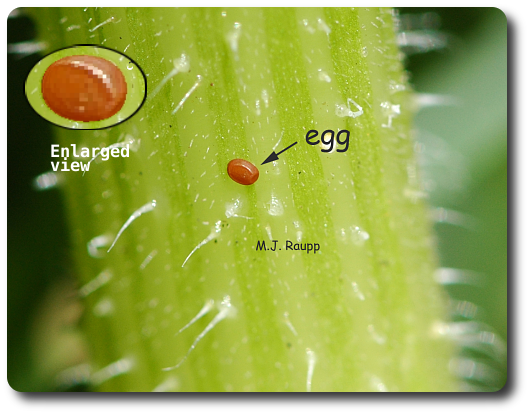One of my favorite gardening pastimes is growing enormous gourds. In late October the largest of these will be transformed into Jack O’ Lanterns. Imagine my dismay upon returning home from an extended journey to find my pumpkin vines withering and one step away from death’s doorstep. The summer drought has been bad, but I suspected the work of some diabolical insect. While pondering my wilted leaves, I saw several red and black waspish insects zipping among the vines. These were not wasps. Rather, they were the adult stage of the squash vine borer.
Tiny caterpillars will hatch from reddish eggs deposited by the female squash vine borer.
The squash vine borer is a moth that mimics a wasp both in coloration and behavior and in this way gains a modicum of protection from predators like birds that could be fooled by this ruse. As the female moth visits the stems and leaves of the pumpkin, she quickly deposits a small reddish egg at each stop. A quick inspection revealed eggs on every leaf and stem of my doomed vines. In a week or so, the eggs hatch and small caterpillars crawl earthward. They bore a hole into the hollow stem often near the junction of leaf and vine. As the caterpillars feed, they push out grainy, yellow or green pellets of excrement known as frass. Frass is a sure sign of squash vine borers. Frass spewed from a bevy of holes lining each meter of my poor vines.
A female squash vine borer takes a break between bouts of laying eggs.
Larvae
Upon splitting open the vine, I was amazed to see several large and meaty caterpillars tunneling through the tender tissue within the stems. As these larvae dine on the vascular tissues, the movement of water and nutrients to the leaves is disrupted. When enough larvae are present, the vine and its attendant leaves wither and die. My vines clearly had enough larvae. After completing their development, caterpillars spin a cocoon, turn into pupae, and then emerge as adults that wage another round of war on the vines. After delivering the coup de grass, the second generation of fully developed larvae spins cocoons. Inside these refuges the larvae or pupae escape the rigors of winter.
Managing for squash vine borer
Next spring, when foolish humans have replanted pumpkins or their relatives, adult moths will emerge from the earth to search for the next crop to ravage. To defeat this pest, some people place nets over their vines in spring to prevent adults from reaching the stems to lay eggs. Others lay down regular applications of insecticides. I usually perform a careful inspection of the vines looking for holes bearing frass. My experience has been that infestations often originate on the primary stem near its exit from the soil. When I find a likely hole, I carefully make a longitudinal incision along the stem to reveal the borer within. Once located, the caterpillar is easily dispatched. Soil can be mounded over the wound and the vine will generate roots at the site. As the name implies, squash are also fair game for this pest and Hubbards are a favorite while butternuts are rarely attacked. I often battle the squash vine borer, sometimes I win and sometimes I lose. The good news is that my pumpkins filled out early this year and are already turning deep orange. My Jack O’Lanterns are secure.
References:
The wonderful reference, Insects of Farm, Garden, and Orchard by Davidson and Lyon, Wiley Press was used as a source of information for this Bug of the Week. To learn more about the squash vine borer, please visit the following web sites.
http://ohioline.osu.edu/hyg-fact/2000/2153.html
http://www.oznet.ksu.edu/dp_hfrr/extensn/problems/squashvb.htm


